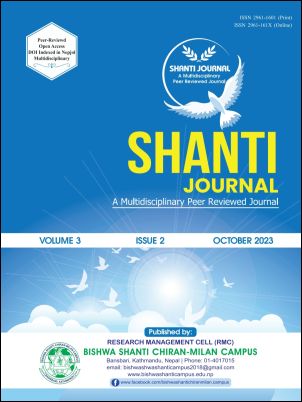Nomadic Lifestyle and Sustainable Livelihood Practices of the Raute
DOI:
https://doi.org/10.3126/shantij.v3i1-2.60852Keywords:
Nomadic, Livelihood, Marginalized, Unique, Lifestyle, forest resource, SustainableAbstract
The study highlights the significance of the Raute community, their unique traditional lifestyle, and the challenges they have faced with. It emphasizes the importance of protecting and supporting marginalized communities like the Raute, as well as the need for equitable development. The main objective of the study is to identify the traditional livelihood practices of the Raute tribe in Nepal. The research was carried out in different districts but was focused on the Raute tribe from Gurans Rural Municipality of karnali province in Nepal. This study used descriptive research techniques to look at quantitative and qualitative data from 149 people between the ages of 18 and 65. Purposive sampling was used to interview 70 Raute people in this age group as well as the Raute leader (Mukhiya). To validate qualitative findings, primary and secondary sources were used, as well as informal conversations took place with key persons of local authorities. The study revealed that the Raute tribe, which consists of 149 people and has 48 percent women, frequently, shifts their dwellings and uses building materials from the forest. They rely on government assistance and forest preservation activities for income because they lack formal education and employment. Child marriage, dangerous deliveries, a lack of awareness about family planning, and a dependence on conventional medicine are all causes for concern. The Karnali Province has taken steps to preserve Raute culture, however due to environmental changes; poverty and a lack of jobs still exist.
Downloads
Downloads
Published
How to Cite
Issue
Section
License
Copyright (c) 2023 The Author(s)

This work is licensed under a Creative Commons Attribution-NonCommercial 4.0 International License.
This license enables reusers to distribute, remix, adapt, and build upon the material in any medium or format for noncommercial purposes only, and only so long as attribution is given to the creator.




